There’s a special comfort found in a dollop of thick fruit puree. It’s delightful whether drizzled over pancakes or swirled into yogurt. Or even when it’s layered in desserts, bringing us back to sunny summer days. The scent of ripe strawberries turning into a smooth puree is more than enticing. It reminds us of the magic simple ingredients make in the kitchen.
In this guide, we dive into making thick fruit puree. We’ll share critical tips and techniques for thickening fruit puree. This enhances the texture and flavor of your recipes. So, let’s start the journey into fruit puree thickening. We aim for every bite to be full of life and joy.
Table of Contents
Key Takeaways
- Mastering thick fruit puree enhances your culinary creations.
- Choosing ripe fruits is crucial for flavor and texture.
- Using the right tools makes the process smoother and more efficient.
- Natural thickening agents can preserve flavor while achieving desired consistency.
- Experimenting with different fruits opens up new flavor profiles.
- Proper storage of puree ensures long-lasting freshness and quality.
Understanding Fruit Puree Consistency
Have you ever wondered about the ideal thickness of fruit puree? It really depends on what you’ll use it for. A thick puree enhances the texture of desserts and sauces. But for drinks and smoothies, a smoother puree is better.
The water content in fruits is key to perfect puree consistency. Berries are naturally smoother due to their high water content. Yet, stone fruits like apricots and peaches might need boiling to reduce their moisture and thicken up.
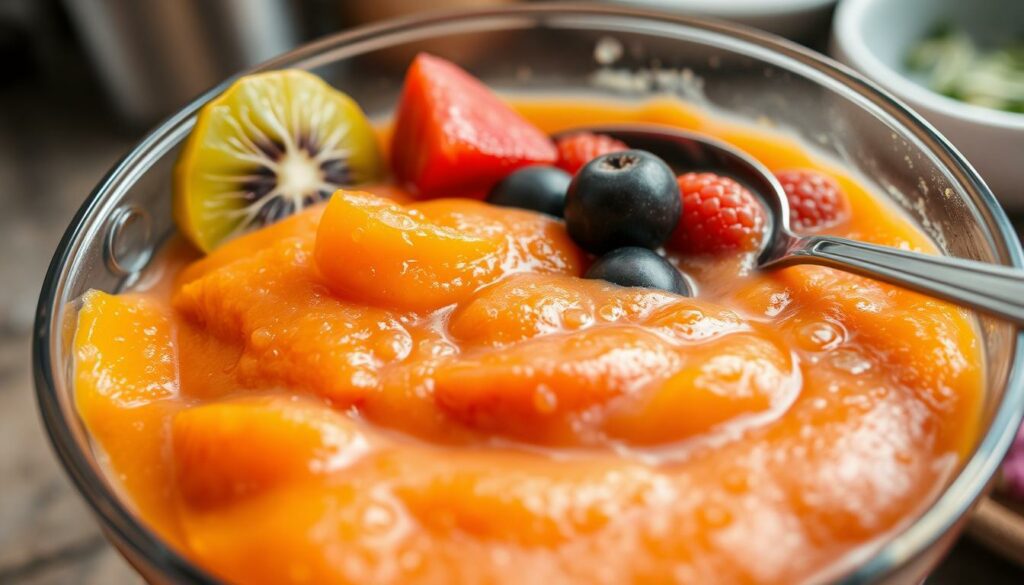
For that perfect thickness, fresh fruits are best for maximum sweetness and flavor. Frozen fruits are also good, capturing peak ripeness. Use a high-speed blender for ultra-smooth purees from soft fruits. A food processor is better for harder fruits or a coarser texture.
When adding sweeteners like sugar or honey, be mindful of the fruit’s natural sweetness. Also, adding preservatives like vitamin C helps keep your puree’s color bright and extends its shelf life.
Here’s a handy table on how different fruits are prepared for purees:
| Fruit Type | Preparation Method | Ideal Consistency |
|---|---|---|
| Berries | Blend fresh or frozen | Smooth |
| Stone Fruits | Boil briefly, then blend | Thick & Creamy |
| Apple | Process cautiously | Varies (Avoid mealy texture) |
| Kiwi & Mango | Blend directly | Smooth |
Experiment and adjust ingredients to get the texture you want. Knowing about fruit puree consistency helps improve your dishes. Learn more about using fruit puree in recipes on simplyummy.com.
Choosing the Right Fruits for Pureeing
Picking the right fruits is key for a great puree. Look for fresh ones based on how firm, ripe, and tasty they are. These features majorly affect how your puree turns out. Bananas, avocados, and peaches are top choices for a thicker blend.
If fresh isn’t an option, frozen fruits work well too. They’re usually picked and frozen when perfectly ripe. Yet, their taste might slightly differ from fresh fruits.
Keep these tips in mind for the best fruit puree:
- Ripeness: Choose perfectly ripe fruits for more sweetness and better flavor.
- Firmness: Go for fruits that aren’t too soft to avoid a runny puree.
- Texture: Fruits that mash well make a smoother puree.
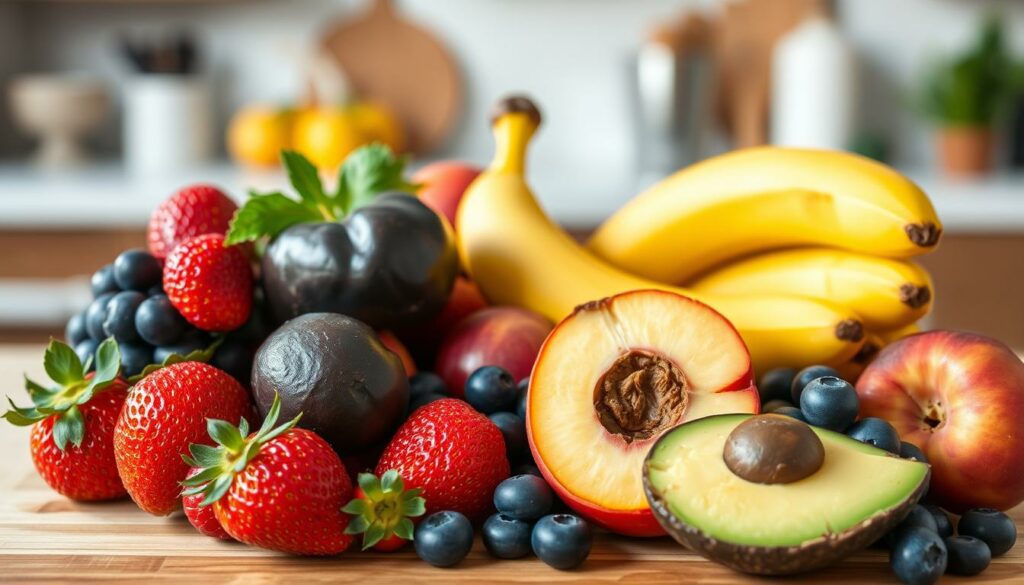
Looking for more puree tips? Check out this resource guide. Mixing different fruits can give new flavors and make your food look good. The right fruit choice improves your purees in taste and texture.
How to Make Fruit Puree Thick?
Want to learn how to make a thicker fruit puree? Let’s dive into fresh vs frozen fruits. The type you pick makes a big difference. Fresh fruits give strong flavors. Frozen fruits are easier to use and are sweetly perfect for purees.
Tips for Selecting Fresh vs. Frozen Fruit
Can’t decide between fresh or frozen fruits for puree? Here are some tips:
- Fresh Fruits: They taste vibrant and can make your puree thicker. However, they’re not always available.
- Frozen Fruits: These are easy to store and use, and they save time. They’re also more affordable, especially in bulk.
- Frozen fruits get sweeter in the freezing process. This makes your puree taste better.
Effects of Different Fruit Types on Thickness
Different fruits make your puree more or less thick. For example:
| Fruit Type | Thickness Potential | Notes |
|---|---|---|
| Strawberries | Medium | Often needs cooking to achieve a thicker consistency. |
| Bananas | Thick | Creates a creamy base naturally, ideal for desserts. |
| Apples | Medium | Good thickening agent when cooked down. |
| Berries (like raspberries) | Thin | Have a tendency to yield a thinner puree; may require thickening agents. |
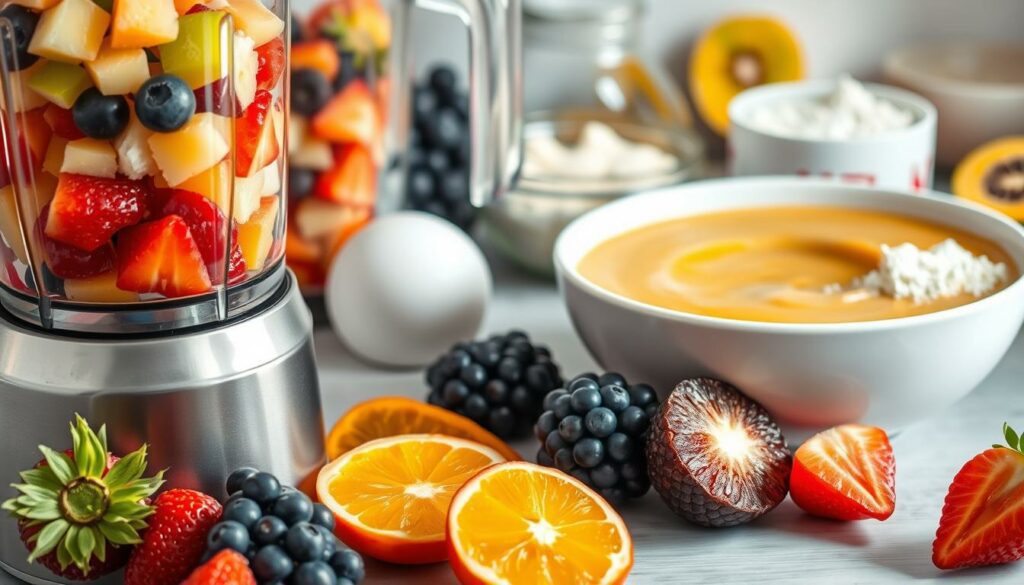
Learning how to thicken your fruit purees adds variety to your dishes. Whether you choose fresh or frozen, the right fruit boosts flavor and texture. It lets you customize purees for different needs.
Essential Tools for Making Thick Puree
To make the perfect fruit puree, you need the right tools. There are several tools you can choose from. Each tool is suited for different fruits and ways of pureeing. Knowing your options will make pureeing fruits easier and more effective.
Using a Blender or Food Processor
A high-speed blender is great for smooth purees, especially with soft fruits like bananas and peaches. On the other hand, a food processor works well for bigger amounts and harder fruits. It offers good pureeing power. Choosing between a blender and a food processor is key, depending on what you need.
Choosing the Right Container for Blending
Picking the right container is important for effective blending or pureeing. Make sure your container is big enough for the fruit you want to use. The right container makes getting a smooth mix easier and cleanup quicker.
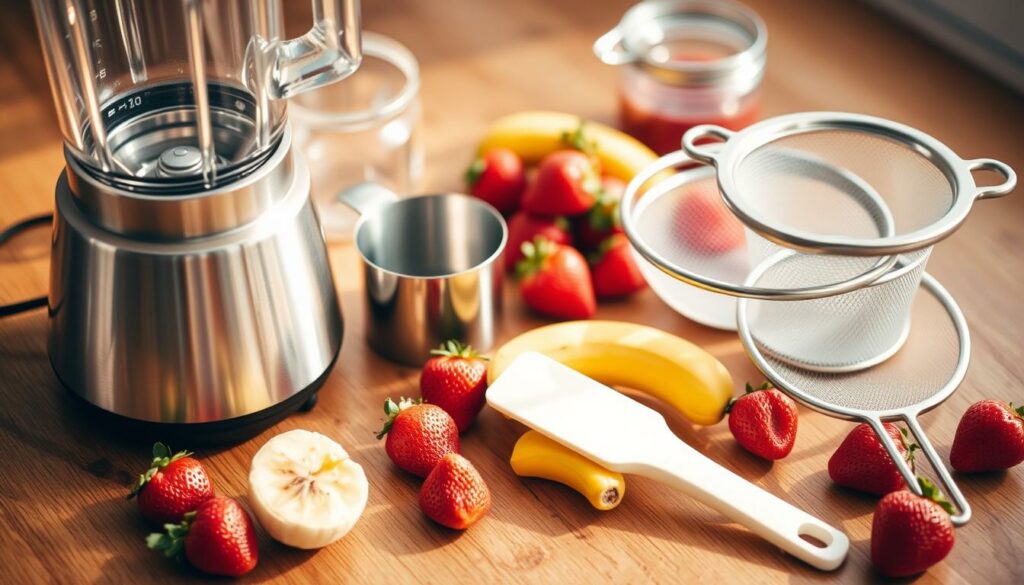
| Tool | Best For | Notes |
|---|---|---|
| Blender | Soft fruits and liquids | Produces very smooth purees |
| Food Processor | Larger quantities and hard fruits | Good for chunkier textures |
| Immersion Blender | Directly in pots | Ideal for soups and sauces |
| Potato Masher/Fork | Softer foods | Manual method for light purees |
| Fine Mesh Strainer | Sifting pulp from soft fruit | Creates smooth textures |
| Manual Food Mill | Cooked fruits and vegetables | Control over thickness |
| Rolling Pin | Mashing cooked fruits | Effective for large batches |
| Knife and Chopping Board | Softer foods | Good for initial preparation |
Thickening Agents for Fruit Puree
When making fruit puree, the thickening agent you pick matters a lot. You have many choices, from natural thickeners to versatile starches. Knowing about these will help you get the consistency you want. This makes your dishes better in quality.
Natural Options: Pectin and Agar-Agar
Pectin is a top natural thickener. Because it comes from fruits, it’s great for fruit purees. Agar-agar, from seaweed, is vegan and thickens nicely. Both of them keep the fruit’s fresh taste and improve texture.
Using Cornstarch and Flour
Cornstarch has double the thickening power of flour. It turns clear when cooked, ideal for colorful fruit pie fillings. Mix 1 tablespoon of cornstarch with water to make a slurry. Usually, 1 teaspoon of cornstarch per cup of juice works well.
Flour is less powerful and suits puddings and gravies. But, it’s not good for acidic foods as it turns them cloudy.
Benefits of Gelatin in Purees
Gelatin thickens purees well, giving them a smooth feel. Melted into fruit puree, it helps bind the texture. As gelatin cools, it sets. This makes it great for desserts that keep their shape but stay delicious. Trying the right amount of gelatin can enhance your recipes.
| Thickening Agent | Description | Best Uses |
|---|---|---|
| Pectin | Natural fruit-derived thickener | Fruit preserves, jellies |
| Agar-Agar | Vegan-friendly seaweed extract | Fruit desserts, puddings |
| Cornstarch | High thickening power, clear when cooked | Fruit pie fillings, sauces |
| Flour | Cloudy finish, thickens in sauces | Puddings, gravies |
| Gelatin | Creates a smooth texture | Desserts, firm purees |
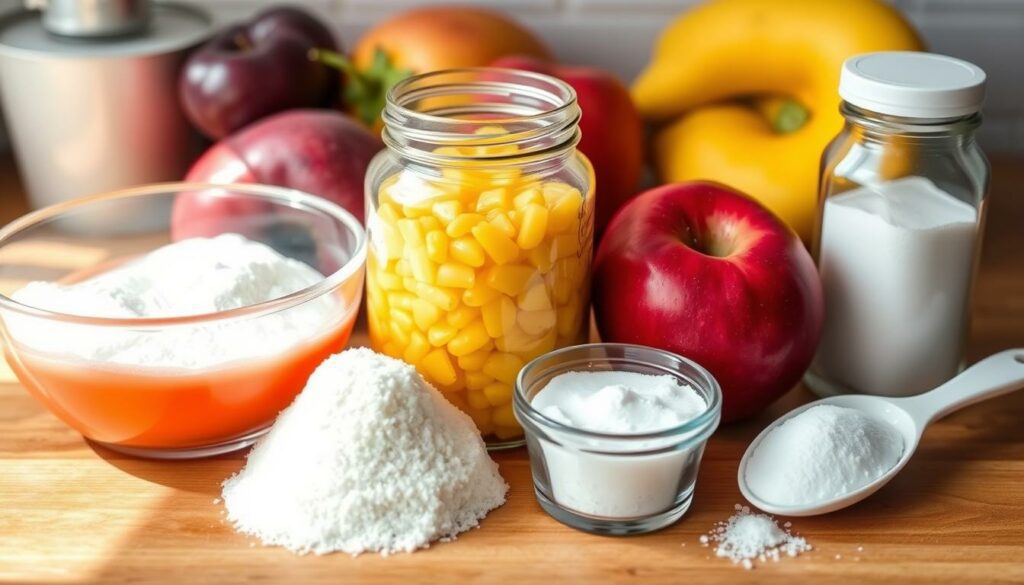
Steps to Thicken Pureed Fruit Without Compromising Flavor
Thickening pureed fruit can make your recipes better. It keeps the important flavors. Use the right ways to cook and add ingredients to make it perfect.
Cooking Method for Enhanced Thickness
Begin by cooking to thicken. Simmer the pureed fruit on low. This makes it thicker and sweeter. For strawberry puree, watch carefully to get the right thickness. Let it cool for 15 minutes after cooking.
Layering Ingredients for Best Results
Add thickeners like cornstarch or pectin slowly. Mix well each time. This lets you make it as thick as you want. You can also add spices or citrus to improve the flavor while thickening the fruit puree.
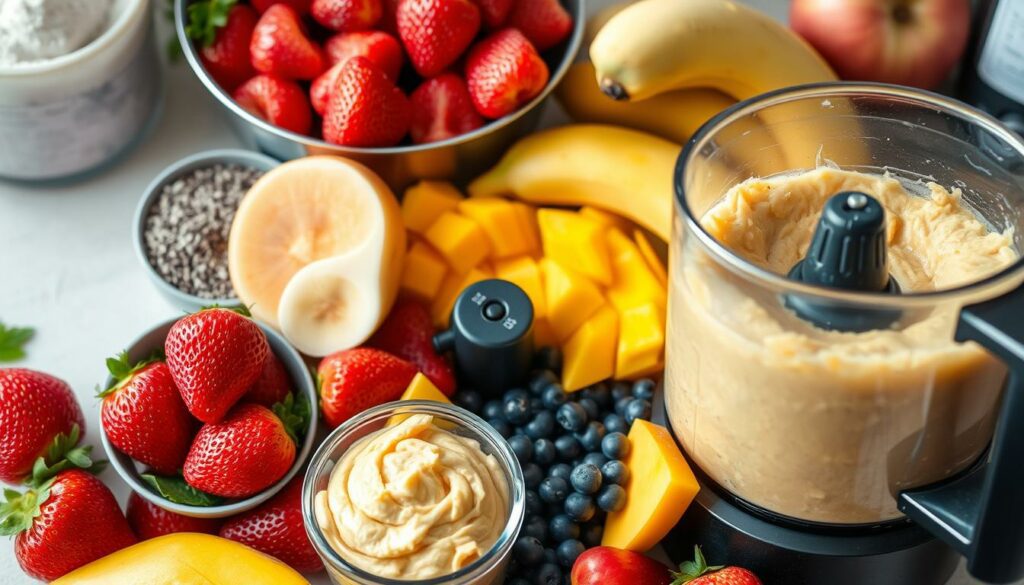
| Cooking Method | Benefits |
|---|---|
| Simmering | Concentrates flavors and enhances sweetness |
| Layering Thickeners | Provides control over consistency and flavor enhancement |
| Gentle Boiling | Achieves a thicker, gelatinous texture |
Creative Ways to Incorporate Thick Puree into Recipes
Thick fruit puree is great in many dishes. It makes the flavor and look of recipes better. This part will show you new ways to use thick fruit puree. You can make regular meals into something special.
Using Fruit Puree in Desserts
Try adding thick fruit puree to your desserts. It’s great as a layer or drizzle on cheesecakes. Using it in coulis can make panna cotta or ice creams pop with color. For instance, raspberry puree can make cakes, mousses, or frozen treats taste better.
Thick Puree as a Drink Base
Using thick fruit puree opens up new drink options. It can change the feel and flavor of cocktails or smoothies. Peach puree, for example, is perfect for a summer spritz. Or, add cranberry puree to a mocktail for more taste.
Adding to Smoothies and Sauces
Adding thick fruit puree to smoothies makes them nutritionally rich and creamy. Blend banana puree with yogurt for a taste of the tropics. Fruit purees also make sauces tastier and more complex. They work well in both sweet and savory dishes. Try mixing different fruits for unique sauce or dressing flavors.
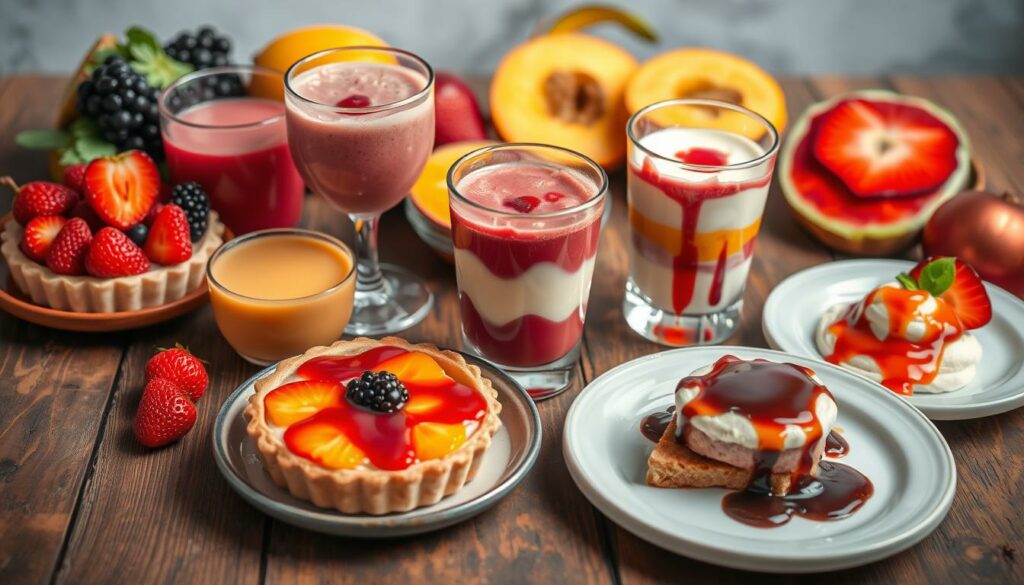
| Recipe Type | Suggested Uses |
|---|---|
| Desserts | Drizzle over ice cream, layer in parfaits, or mix into cake batters |
| Beverages | Use as a base for smoothies, cocktails, or refreshing mocktails |
| Dressings and Sauces | Blend into salad dressings or enhance savory sauces |
| Frozen Treats | Incorporate in sorbets, popsicles, or ice creams |
| Confections | Add to lollipops, candies, or cake icings |
Trying out these ways to use thick fruit puree can spark your creativity in cooking. It also makes your fruit puree recipes better. With so many fruit flavors like passionfruit or blackberry, you can always find new mixes that you like. Plus, you can change them based on what’s in season.
Storage Tips for Homemade Fruit Puree
Storing your homemade fruit puree the right way keeps its taste and health benefits fresh. By using the right fridge and freezer methods, you can make your puree last longer. This way, you get to enjoy your delicious creation for more days.
Refrigeration Guidelines
After making your fruit puree, putting it in the fridge correctly is key. Use airtight containers to stop it from picking up other smells or getting spoiled. Your puree will stay fresh in the fridge for about a week. Don’t forget to mark the containers with the prep date.
Freezing Puree for Long-Term Use
For keeping your fruit puree longer, freezing is your best bet. Use ice cube trays or zip-top bags for easy freezing. Once they’re frozen, put them in a labeled bag or container. They’ll stay good for up to six months. When you want to use them again, thaw only what you need in the fridge. This keeps the puree tasting great.
Common Mistakes to Avoid When Thickening Fruit Puree
Making the perfect fruit puree is a tricky task. Avoiding certain mistakes can make your dish much better. Attention to detail helps keep the natural taste and feel of the fruit. It’s crucial to know these errors to avoid them and get the best outcome.
Over-Cooking and Its Effects on Flavor
Over-cooking is a big mistake in thickening fruit puree. Cooking for too long can make you lose the fruit’s fresh taste and health benefits. Overcooked fruit turns mushy, and the puree won’t look or taste good. Watch how long you cook it. Take it off the heat when it’s just right.
Using Too Much Sweetener
Adding too much sweetener is another mistake. Fruits naturally have sweetness, which too much sugar or syrup can hide. With too much sweetener, the puree tastes fake sweet, not like the real fruit. Use just enough to enhance the fruit’s flavor, not cover it up.
| Mistake | Effects | How to Avoid |
|---|---|---|
| Over-Cooking | Loses natural flavor and nutrients | Monitor cooking time, remove at thickness target |
| Using Excessive Sweetener | Overpowers fruit’s natural taste | Use moderate sweeteners to enhance flavors |
Avoid these mistakes to keep your fruit purees tasting real and delicious. Changing how you make them can lead to tastier results. Your dishes will have the true taste of fruit.
Benefits of Thickening Fruit Puree Naturally
Thickening fruit puree naturally has many health and flavor benefits. When you use natural thickeners, you keep the fruit’s nutrients and great taste. This makes your fruit puree both healthy and delicious.
Health Benefits of Using Natural Thickening Agents
Natural thickeners are good for people of all ages. They make purees thicker, adding important nutrients. For example:
- Applesauce is a healthier baking alternative to butter.
- Banana puree adds texture and potassium.
- Pumpkin puree boosts fiber and vitamins in meals.
This makes digestion better and improves health overall. Plus, natural thickeners are better than commercial ones. They’re less costly and easier on your stomach.
Flavor Preservation and Texture Improvement
Natural thickeners keep your food tasting great. They maintain the real flavor and smell of your ingredients. For instance, mango puree brings tropical notes, while strawberry puree adds a bright sweetness.
You can adjust the thickness to get the texture just right. This helps blend flavors and textures well.
Trying different fruit mixes can make your cooking exciting and healthy. Use these thickeners to make your meals tastier and better for you.
Experimenting with Different Flavor Combinations
Exploring different flavor combinations in fruit puree sparks culinary creativity. This can improve your baking or help you make tasty sauces. Knowing how to mix fruits can enhance your dishes.
By combining various fruits, you create new, exciting flavors. These flavors can delight anyone who tries them.
Best Fruit Pairings for Sweet Purees
Here are some top pairings to try:
- Strawberries and bananas for a classic, sweet mix.
- Mango and lime add a tropical twist.
- Apples and cinnamon for a cozy taste.
- Peaches and raspberries blend sweet with tart.
- Pumpkin and chai spices for a hint of fall.
Using Citrus to Balance Flavor
Citrus can make fruit pureés taste better by balancing the sweetness. Lemons and limes add brightness and acidity. This enhances the taste of your creations.
As you try these mixtures, expect some surprises. Let your creativity shine in the kitchen!
Thick Fruit Puree Recipe to Try
Making your own thick fruit puree is easy and fun. This recipe focuses on freshness and lets you be creative. You can try different fruits for making purees. They’re great for desserts, spreads, or sauces.
Ingredients for a Basic Thick Fruit Puree
- 2 cups of ripe fruit (such as strawberries, peaches, or plums)
- 1/2 cup of sugar
- 1 tablespoon of lemon juice
Step-by-Step Instructions
- Select your fruit: Pick two to three cups of ripe fruit. You can use fresh or frozen ones.
- Prepare the fruit: Wash, peel, and cut the fruit into small pieces. This helps them cook evenly.
- Combine ingredients: Put the fruit, sugar, and lemon juice in a saucepan. This mix will taste great.
- Cook the mixture: Cook it on medium or low heat. Stir now and then. It usually takes 20 to 25 minutes for 500g of fruit.
- Blend to desired consistency: After cooking, blend it until it’s how you like it. Smooth or chunky, it’s up to you.
- Store the puree: Put the puree in jars or containers to freeze. You can keep it for later.
You can keep this puree in the fridge for 2-3 weeks or freeze it. Try adding vanilla or almond for more taste. This guide will help you make a tasty puree for your meals. For more ideas, here’s a cool passion fruit puree recipe to try.
Conclusion
Summing up, the key to thick fruit puree lies in choosing the right fruits and thickeners. Making sure everything is tailored to your needs is vital for your recipes’ success. Whether it’s for desserts, smoothies, or baby food, getting the thickness right matters a lot.
Diving into the world of fruit purees is exciting. It lets you try out yummy flavor mixes using pure, natural stuff. It’s all about using the correct techniques to make your food stand out. So, take this chance to get creative with simple recipes and make something special that everyone, including babies, will love.
Remember, keeping the freshness and taste is key when you’re making purees. Homemade purees not only lead to eating healthier but also add fun to cooking. So why wait? Start making thick fruit purees for your meals and see the difference it makes!
FAQ
How do I make fruit puree thicker?
To thicken fruit puree, opt for fruits like bananas or avocados. They have less water. Also, use thickening agents such as cornstarch, pectin, or agar-agar. Gently cooking the fruit can help thicken it by concentrating its sweetness.
What fruits are best for making a thick puree?
Bananas, avocados, peaches, and cooked apples are great for thick purees. They naturally have a thicker consistency. Using frozen fruits is also a good choice, offering ease and nutritional benefits.
Can I use frozen fruit for purees?
Yes, you can use frozen fruit for purees. They’re picked at peak ripeness, so they’re tasty and full of flavor. Just know, they might make the texture a bit different from fresh fruit.
What are some natural thickening agents for fruit puree?
Pectin, agar-agar, and gelatin are natural thickeners for fruit puree. They help make the puree thicker. And they add health benefits without using fake stuff.
How can I avoid common mistakes when thickening fruit puree?
Don’t cook the fruit too much. It can lose flavor and texture. Also, don’t add too much sugar. It can hide the fruit’s own sweetness. Focus on bringing out what’s naturally there.
What are some creative uses for thick fruit puree?
Thick fruit puree is great in many recipes. Use it as a dessert topping, in smoothies, or in sauces. Mix it into yogurt or as pastry filling. It’s very versatile.
How should I store homemade fruit puree?
Store homemade fruit puree in airtight containers in the fridge for up to a week. For longer storage, freeze it. Frozen, it can last up to six months.
What is the ideal consistency for fruit puree?
The perfect puree consistency depends on its use. Thicker puree works for desserts and sauces. A smoother one is great for drinks. Finding the right balance between thick and smooth is key.
Can I use thickeners to improve the texture of fruit puree?
Yes, thickeners like cornstarch and flour can improve fruit puree texture. They make it thicker while keeping the fruit’s flavors.
What are some tips for selecting the right container for blending fruit puree?
Pick a container big enough for the fruit amount without spilling. Choose one that’s easy to clean. Glass or stainless steel is good because they don’t stain easily.

